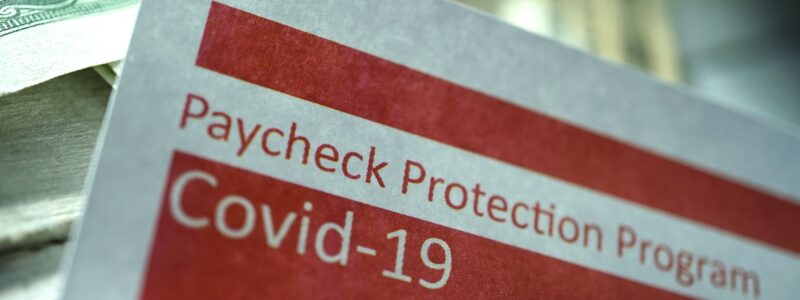On May 15, the Small Business Administration (SBA) released the long-awaited Paycheck Protection Program (PPP) Loan Forgiveness application and instructions. While there is not yet clear guidance on the details of loan forgiveness (the SBA plans to release regulations and guidance soon to assist borrowers as they complete their loan forgiveness applications and instruct lenders on how to handle their responsibilities related to PPP loans), the summary below provides an overview of the SBA’s key points under this release.
- Options for borrowers who use a biweekly or more frequent payroll schedule to calculate payroll costs using an “alternative payroll covered” period that aligns with borrowers’ regular payroll cycles.
- Flexibility to include eligible costs incurred but not paid during the eight-week period after receiving their PPP loan. Form instructions state these incurred expenses must be paid by the next payroll or billing cycle to be included.
- Step-by-step instructions on how to perform the calculations required by the CARES Act to conform eligibility for loan forgiveness. (K·Coe has provided a high-level overview below.)
- Implementation of statutory exemptions from loan forgiveness reduction based on rehiring by June 30.
- Addition of a new exemption from the loan forgiveness reduction for borrowers who have made a good-faith, written offer to rehire workers that was declined by the workers, fired with cause, or voluntarily resigned.
Instruction for PPP Loan Borrowers
Excess of $2 million: The loan forgiveness application has a checkbox to mark if the borrower (together with affiliates, if applicable) received PPP loans in excess of $2 million.
All borrowers need to retain files for six years: The application states that all borrowers must retain all documentation regarding eligibility, necessity of the loan, and documents supporting amounts paid – including cancelled checks, leases, employee records, etc. – for six years to permit SBA and OIG to access files upon request for review.
Alternative Payroll Covered Period (APCP) election requirements
Borrowers with a biweekly or more frequent payroll schedule (semi-monthly, monthly payroll or less frequent than biweekly are not eligible) may elect to calculate eligible payroll costs using the eight-week (56 day) period that begins on the first day of their first pay period following their PPP disbursement date. This period only applies to payroll costs – it does not apply to non-payroll costs. For example, if your loan disbursement date is Monday, April 20, and your next pay period begins on Sunday, April 26, your APCP is 4/26 through 6/20.
If you elect to use the APCP, you must use that period for the following calculations and documentation: payroll costs, health insurance costs, employer retirement plan contributions, amounts paid for state and local employer taxes on compensation, amounts paid to owner-employees (self-employed individuals and general partners), average FTE calculations, and salary and hourly wage reductions.
Eligible Expenses
Payroll Costs: Compensation
- Report separately employees who earn under $100k (annualized), employees who earn over $100k (annualized), and employee-owners, self-employed individuals, or general partners. Worksheets are provided within the application instructions to compute payroll cost.
- Required documentation for the covered period (or APCP): The instructions outline numerous required documents regarding payroll cost, full-time equivalent and non-payroll costs be submitted with the application for forgiveness, including:
- Bank or payroll provider statements documenting payroll expenses paid or incurred
- Form 941s for the quarter (or quarters, if period covers more than one quarter)
- State wage reports (if applicable)
- Quarterly SUTA reports or filings
- Owners Compensation: In addition to owners’ compensation being capped at $15,385 per individual during the eight-week covered period, it is also limited to no more than eight weeks- worth of compensation paid to the owner during 2019 (preventing owners from increasing compensation to themselves during the covered period).
Payroll Costs: Paid and Incurred Clarification
- A borrower can include costs paid during the Covered Period or APCP, meaning either (1) checks were distributed during the period, or (2) the borrower originated an ACH transfer during the period.
- A borrower can also include costs that were incurred in the period. Costs are incurred on the day the employee earns the pay. Costs that are incurred but not paid during the period are eligible for forgiveness if they are paid on, or before, the next regular payroll date.
Non-Payroll Costs
- The application calculates the 25% limit by taking total eligible payroll costs and dividing by 0.75 to get the total eligible forgiveness amount.
- Mortgages for real and personal property, rent obligations, and covered utility payments must have been in force on, or before, February 15, 2020.
- Special Rule for Amounts Incurred: amounts incurred for non-payroll expenses may be either paid during the period, or incurred during the covered period if paid on or before the next regular billing date. For example, borrower receives PPP funds on April 20, and covered period ends on June 14. Borrower receives its electric bill for its May usage on June 12, due June 20. The electric bill is a utility cost that has been “incurred,” and can be included on the borrower’s forgiveness application, if the borrower pays the bill on or before June 20.
- Supporting documents required: payment receipts, cancelled checks, copies of current lease agreements, lender amortization schedules, utility invoices, account statements, etc.
Adjustments for Full-Time Equivalency (FTE) and Payroll Reductions
FTE Defined in Application: FTE will be calculated based on 40 hour/week. Owners are not included in the FTE calculations. A simplified method assigns a 1.0 for employees who work 40 hours or more per week and .5 for employees working fewer hours.
FTE Safe Harbor: If there was not a reduction in the number of FTEs or average paid hours of employees comparing 01/01/20 and the end of the Covered Period, a reduction in forgiveness due to change in FTE will not be required.
FTE Reduction: The average FTE during the covered period is compared to the most beneficial average FTE during the following dates:
- 02/15/19 – 06/30/19
- 01/01/20 – 02/29/19
- 12-week period between 05/01/19 and 09/15/19 (Seasonal employer only)
FTE Reduction Exceptions: A reduction in FTE will not be considered a reduction if (1) the borrower has made a good-faith, written offer to rehire an employee which was rejected and (2) any employees during the covered period were fired for cause, voluntarily resigned, or voluntarily requested and received a reduction of their hours. (These apply only if the position was not filled by a new employee.)
FTE Reduction Safe Harbor: If the FTEs for the pay period that includes 02/15/20 is less than the average FTEs for the period of 02/15/20 through 04/26/20, the employer is not eligible for the exemption. If FTEs were reduced between the periods, the forgiveness reduction due to FTE would be exempt (if the FTEs as of 06/30/20 are equal to or greater than the FTEs for the pay period including 02/15/20).
Salary/Hourly Wage Reduction: Implements a three-step process to determine the reduction in forgiveness based on reductions in employees’ wages. This must be calculated for each employee earning less than $100k (annualized).
- Step 1: Determine if pay was reduced more than 25%.
- Step 2: Determine if Safe Harbor is met.
- Step 3. Determine Salary/Hourly Wage Reduction.
This documentation must be retained by the borrower but is not required to be submitted to the lender.
Contact a K·Coe advisor with questions regarding the PPP loan forgiveness application, record-keeping, or calculations under the SBA’s guidance.









